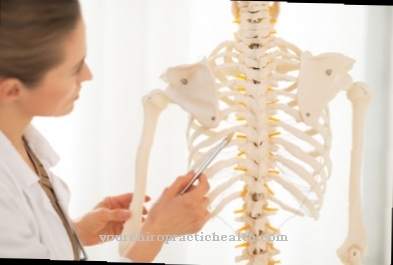The Aneuploidy screening is used to determine numerical chromosome aberrations in in vitro generated embryos which are intended for implantation. It is a cytogenetic examination, in which only numerical aberrations of certain chromosomes can be determined. The aneuploidy screening is thus a form of pre-implantation diagnosis (PGD).
What is aneuploidy screening?

The term aneuploidy screening is used to summarize cytogenetic examination methods that can give an indication of numerical aberrations in certain chromosomes in in vitro fertilization (IVF). In principle, the aneuploidy screening can provide indications of nullosomy, monosomy and polysomy such as B. give the trisomy.
In nullosomy, a chromosome pair is completely missing, in monosomy one homologous chromosome of a chromosome pair is missing and in polysomy there are more than two homologous chromosomes for a particular chromosome pair. The most famous polysomy is trisomy 21, which leads to Down syndrome. Since most numerical chromosome aberrations - especially monosomies - are lethal, i.e. lead to natural terminations, miscarriages or stillbirths, only embryos without recognizable chromosomal aberrations are implanted in the uterus.
This should improve the success rate of IVF, but certain chromosome aberrations are not necessarily fatal, but lead to abnormalities and severe limitations in later life, such as in Down's or Turner's syndrome. This is why some countries have a general ban or severe restrictions on this type of pre-implantation diagnosis (PGD) for ethical reasons.
Function, effect & goals
The aneuploidy screening is only used for in vitro fertilization. The most important goal is to only transfer embryos without recognizable chromosome aberrations into the uterus in order to get the highest possible chance of success for a pregnancy with artificial insemination. In principle, a distinction can be made between the two methods of polar body diagnosis and examination on the pre-implantation embryo. The first method involves examining the polar bodies of the egg cell that has not yet been fertilized.
Only possible aneuploidy of the egg cell is checked here. This is done on the assumption that about 90% of aneuploidies are of maternal origin. It is therefore not a PGD in the narrower sense, but a prefertilization diagnosis, because no fertilization, i.e. no fusion of the egg with a sperm cell, has taken place. The aneuploidy screening on the pre-implantation embryo in the early blastula stage, on the other hand, qualifies as PGD because the examination relates to the "real" embryonic stage - even if it is a very early stage, only a few days old.
In polar body diagnostics, the two polar bodies that the egg cell forms during the first and second meiosis before it merges with the sperm cell are removed and examined for aneuploidy. The so-called FISH test (fluorescence in situ hybridization) is used to determine any aneuploidy that may be present. So far, the FISH test has only allowed the examination of chromosomes 13, 16, 18, 21, 22 and the sex chromosomes X and Y. The chromosomes of the double helix structure split after meiosis connect to the respective complementary DNA sequence using chromosome-specific DNA probes.
The DNA probes are marked with different fluorescent colors. The homologous chromosomes can be counted under the light microscope in a semi-automated process so that numerical aberrations can be identified. Analogous to polar body diagnosis, aneuploidy screening is carried out on pre-implantation embryos, which are still in the early blastomer stage. Now, however, we are dealing with diploid sets of chromosomes, the double helix of which must first be split up in order to initiate the connection of the chromosomes with the complementary DNA probes.
The aim of the aneuploidy screening in both methods remains a positive selection of the in vitro fertilized egg cell before it is transferred to the uterus, in order to achieve the highest possible success rate for the desired pregnancy. A much-discussed ethical problem arises from the negative selection, which is automatically linked to the positive selection and which some extreme critics like to use arguments to bring it close to eutanasia. Another ethical problem is seen with the use of IVF to generate the so-called rescue baby. A positive selection of embryos generated in vitro can be used to cultivate omnipotent immunocompatible stem cells that could save the lives of siblings with certain diseases through implantation.
Risks, side effects & dangers
The aneuploidy screening itself as well as the extraction of the cell nuclei to be examined takes place outside the body and therefore does not involve any direct risks or dangers to health and is therefore free of side effects. The actual risks and dangers lie in the fact that the benefit of anoiploidy screening on blastomeres, i.e. on pre-implantation embryos, to increase the success rate with regard to the desired pregnancy has not yet been achieved.
General, systemic problems arise due to exaggerated expectations of the precision of the screening results. This applies to the positive as well as the negative result. A positive result, i.e. at least one chromosomal aberration was found, is associated with a certain uncertainty. It can happen that the positive result wrongly excludes the corresponding egg cell from being transplanted, although in reality there is no chromosome defect. This type of misdiagnosis is less due to the procedure itself than to the fact that embryos in the blastula stage can have a few cells with chromosome aberrations.
On the other hand, the prospective parents of an IVF child must not be sure that if the aneuploidy test is negative, there is actually no chromosomal aberration. Another danger arises when the necessary number of cells is removed from the embryo. It happens that the cells taken by biopsy die and can no longer be examined. Since the biopsy can no longer be repeated on the same embryo, it is no longer available for a transplant because there is no test result. It is also discussed to what extent the biopsy affects the embryo's fertility, so that the overall success rate for pregnancy is affected.



























